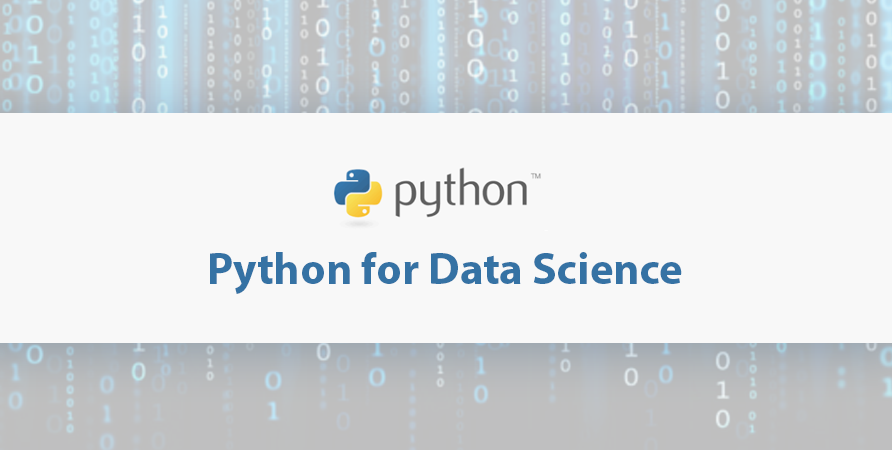Data; in any form is now the most valued asset over the world. The term Data in this article refers to a collection of facts such as numbers, words, measurements, and observations that have been translated into a form that computers can process. Data Science is the concept of analyzing and extracting useful information from these massive troves of data. The practice of data science requires the use of analytical tools, technologies and languages for assistance in the extraction of insights as well as value from data. Python is the preferred programming language for data scientists. It is an easy-to-use language that has decent library availability and great community participation.
What is Python?
Python is an interpreted, dynamically-typed language with a precise and efficient syntax. It is relatively easy to learn and portable. This means its statements can be interpreted in a number of operating systems, including UNIX-based systems, Mac OS, MS-DOS, OS/2, and different versions of Microsoft Windows 98. The core advantage of Python language is its indenting of source statements to make the code easier to read.
Advantages:
> Python has presence of third party modules making it capable of interacting with most other languages and platforms.
> It provides a large standard library which includes areas like internet protocols, string operations, web services tools, and operating system interfaces.
> It is developed under an open source license which makes it free to use and distribute, including for commercial purposes.
> Python has clean object-oriented designs and provides enhanced process control capabilities. It also features text processing capabilities.
How does Python help Data Science?
The process of data science does involve extracting useful information from massive stores of statistics, registers and data. These data are usually unsorted and difficult for the accurate information of any insight. Python features several machine learning libraries and can be useful for performing tasks such as data cleaning and data-munging, along with other data pre-processing tasks. This programming language comes with numerous libraries for scientific computing, analysis and visualization.
> Numpy: It stands for 'Numerical Python'. It is very useful for performing mathematical and logical operations on Arrays.
> Matplotlib: It is a powerful library for visualization in Python. It can be used in Python scripts, shell, web application servers, and other GUI toolkits.
> Scikit-learn: It is a free library which contains simple and efficient tools for data analysis and mining purposes. Various algorithms such as logistic regression and time series algorithm can be implemented using scikit-learn.
> Seaborn: It is a statistical plotting library in Python. Seaborn is best known for its beautiful default styles and a high level interface to draw statistical graphics.
> Pandas: This is an important library in Python for data science. It is used for data manipulation and analysis. Pandas is well suited for different data such as tabular, ordered and unordered time series, matrix data etc.
SGS Technologie specializes in data analytics and data science. In addition, we have subject-matter-experts in the Python programming language with immense experience of utilizing the tool for Data Science Development. Share your data analytical requirements with us at info@sgstechnologies.net. You may also visit our headquarters in Jacksonville, Florida or any of our branches.

<script type="application/ld+json">
{
"@context" : "http://schema.org",
"@type" : "Article",
"name" : "Why use Python for Data Science?",
"author" : {
"@type" : "Person",
"name" : "SGS"
},
"image" : "https://www.sgstechnologies.net/sites/default/files/2020-01/Python%20for%20Data%20Science.png",
"articleSection" : "Data; in any form is now the most valued asset over the world. The term Data in this article refers to a collection of facts such as numbers, words, measurements, and observations that have been translated into a form that computers can process.",
"articleBody" : "Data Science is the concept of analyzing and extracting useful information from these massive troves of data. The practice of data science requires the use of analytical tools, technologies and languages for assistance in the extraction of insights as well as value from data. Python is the preferred programming language for data scientists. It is an easy-to-use language that has decent library availability and great community participation.</P>\n\n<P><STRONG>What is Python?</STRONG></P>\n\n<P>Python is an interpreted, dynamically-typed language with a precise and efficient syntax. It is relatively easy to learn and portable. This means its statements can be interpreted in a number of operating systems, including UNIX-based systems, Mac OS, MS-DOS, OS/2, and different versions of Microsoft Windows 98. The core advantage of Python language is its indenting of source statements to make the code easier to read.</P>\n\n<P><STRONG>Advantages:</STRONG></P>\n\n<P>> Python has presence of third party modules making it capable of interacting with most other languages and platforms.</P>\n\n<P>> It provides a large standard library which includes areas like internet protocols, string operations, web services tools, and operating system interfaces. </P>\n\n<P>> It is developed under an open source license which makes it free to use and distribute, including for commercial purposes.</P>\n\n<P>> Python has clean object-oriented designs and provides enhanced process control capabilities. It also features text processing capabilities.</P>\n\n<H2>How does Python help Data Science?</H2>\n\n<P>The process of data science does involve extracting useful information from massive stores of statistics, registers and data. These data are usually unsorted and difficult for the accurate information of any insight. Python features several machine learning libraries and can be useful for performing tasks such as data cleaning and data-munging, along with other data pre-processing tasks. This programming language comes with numerous libraries for scientific computing, analysis and visualization.</P>\n\n<P><STRONG>> Numpy</STRONG>: It stands for �Numerical Python�. It is very useful for performing mathematical and logical operations on Arrays.</P>\n\n<P><STRONG>> Matplotlib</STRONG>: It is a powerful library for visualization in Python. It can be used in Python scripts, shell, web application servers, and other GUI toolkits.</P>\n\n<P><STRONG>> Scikit-learn</STRONG>: It is a free library which contains simple and efficient tools for data analysis and mining purposes. Various algorithms such as logistic regression and time series algorithm can be implemented using scikit-learn. </P>\n\n<P><STRONG>> Seaborn</STRONG>: It is a statistical plotting library in Python. Seaborn is best known for its beautiful default styles and a high level interface to draw statistical graphics.</P>\n\n<P><STRONG>> Pandas</STRONG>: This is an important library in Python for data science. It is used for data manipulation and analysis. Pandas is well suited for different data such as tabular, ordered and unordered time series, matrix data etc. </P>\n\n<P>SGS Technologie specializes in data analytics and data science. In addition, we have subject-matter-experts in the Python programming language with immense experience of utilizing the tool for Data Science Development. Share your data analytical requirements with us at <A href=\"mailto:info@sgstechnologies.net\">info@sgstechnologies.net</A>. You may also visit our headquarters in Jacksonville, Florida or any of our branches",
"url" : "https://www.sgstechnologies.net/blog/why-use-python-data-science",
"publisher" : {
"@type" : "Organization",
"name" : "SGS"
}
}
</script>










